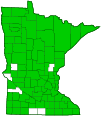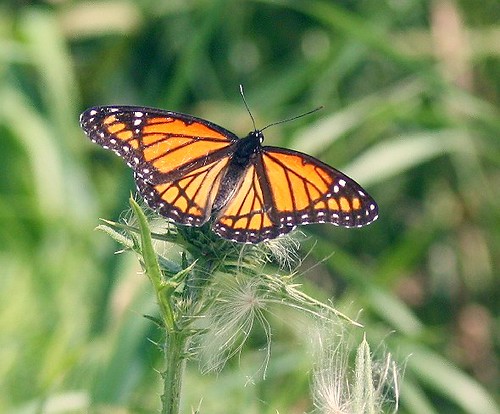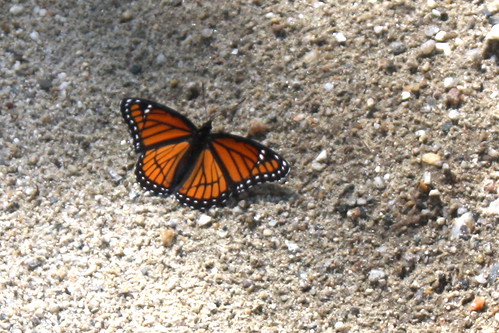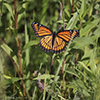viceroy
(Limenitis archippus)
Conservation • Description • Habitat • Ecology • Distribution • Taxonomy
Conservation Status |
|
|||||||
| IUCN Red List | not listed |
|||||||
| NatureServe | N5 - Secure S5 - Secure |
|||||||
| Minnesota | not listed |
|||||||
Description |
||
Viceroy is a medium-sized brush-foot butterfly. It was once thought to be a Batesian mimic, a non-poisonous species that shares a common predator with a poisonous species, and has evolved to imitate the warning signals of that species, in this case the monarch. Recent research indicates that the viceroy is also poisonous, at least in some parts of its range (Florida). That makes the viceroy a Müllerian mimic, a poisonous species that has coevolved with another poisonous species to imitate each other’s warning signals. Adults have a wingspan of to 2½″ to 3⅜″. The upperside of both wings is orange with heavy black veins. The subapical area of the forewing has a single row of 2 to 4 white spots. The outer margin has a broad, black border with a single submarginal row of white spots. There is also a prominent series of white, crescent-shaped marks (lunules) on the margin. The leading edge (costal) margin has a broad, black border with a single white spot in the apical area and a single poorly defined white spot near the middle. The inner margin has a broad black border on with no spots. On the leading edge of the forewing cell there is a small V-shaped indentation which sometimes contains a small white spot. The upper side of the hindwing has a broad, black border on the outer margin with a single row of white spots, a prominent series of white lunules, and a curved, black postmedian line. The underside of both wings is similarly marked but the hindwing and the tip of the forewing are pale orange. The small white spot on the leading edge of the forewing cell, though often missing on the upperside, is always present. The white spots in the border of the outer margin are larger. There is a faint, white, “ghost” spot between the submarginal spots and the lunules. Seen from above, the body is black with usually no white markings. The head, seen from above, is black, with a band of four white spots near the “neck” and a white spot at the base of each antenna. The eyes and legs are black. The male and female look alike. The caterpillar is up to 2″ long. It is a bird dropping mimic. The thorax and abdomen are mottled medium and dark olive green. A pair of long, black, spiny, branched projections (scoli) extend over the head from a hump on the second thoracic segment. There is a pair of large, greenish-yellow humps on the on the upper (dorsal) side of the second abdominal segment. Each hump is tipped with a small cluster of short white spines. There are similar, smaller humps on the seventh and eighth abdominal segments. A white subspiracular stripe extends from the second to the last abdominal segment. A white “saddle” on the dorsal surface from the fourth through sixth abdominal segments extends down the sides near the middle and merges with the subspiracular stripe. The head is brown and has a pair of short, brown scoli. The prolegs are brown. Mature caterpillars are found from late May onward. |
||
Size |
||
Wingspan: 3⅜″ to 4¼″ |
||
Similar Species |
||
| Monarch (Danaus plexippus) is larger, with a wingspan up to 4¼″. There is a double row of white submarginal spots in the black border on the outer margin. In the subapical area there are five small spots, four pale orange and one white or pale orange, arranged as two short lines of spots. There is no curved, black, postmedian line on the hindwing. | ||
Habitat |
||
Wet areas with willows, meadows, valley bottoms, and other open areas near water. |
||
Ecology |
||
Season |
||
Two broods: late May to July and late July to September. |
||
Behavior |
||
Caterpillars feed at night. They make a ball of leaf bits, dung, and silk, and dangle it from the leaf on which they are feeding, possibly to distract predators. The adult have a slow flap and glide pattern that is similar to the monarch. |
||
Life Cycle |
||
The male perches for a short time waiting for a female to pass, then patrols near host plants in search of a female for a short time, then finds another perch. After mating, the female lays green eggs singly at the tip of host plant leaves. She will lay no more than 2 or 3 eggs per plant. After hatching, the caterpillar eats its egg casing. The larva molts four times before pupating. In the fall the third stage caterpillar of the second brood forms a shelter (hibernaculum) by rolling a leaf and tying it with silk. It overwinters in the hibernaculum. |
||
Larva Hosts |
||
Mostly leaves and catkins of poplar (Populus spp.) and willow (Salix spp.), but also leaves of apple (Malus spp.) and cherry (Prunus spp.). |
||
Adult Food |
||
Aphid honeydew, carrion, dung, and decaying fungi in the spring; nectar from small white flowers including Joe Pye weed (Eutrochium), goldenrod (Solidago), and aster (Symphyotrichum) in the summer. |
||
Distribution |
||||
|
Sources |
|||
| 9/30/2023 | ||||
Occurrence |
||||
|
||||
Taxonomy |
|||
Order |
Lepidoptera (Butterflies and Moths) | ||
Superfamily |
Papilionoidea (Butterflies) | ||
Family |
Nymphalidae (Brush-footed Butterflies) | ||
Subfamily |
Limenitidinae (admirals and relatives) | ||
Tribe |
Limenitidini | ||
| Subtribe | Limenitidina | ||
Genus |
Limenitis | ||
Subordinate Taxa |
|||
eastern viceroy (Limenitis archippus archippus) Florida viceroy (Limenitis archippus floridensis) Nevada viceroy (Limenitis archippus lahontani) southwest viceroy (Limenitis archippus obsoleta) viceroy (Limenitis archippus hoffmanni) viceroy (Limenitis archippus idaho) Watson’s Gulf Coast viceroy (Limenitis archippus watsoni) |
|||
Synonyms |
|||
|
|||
Common Names |
|||
viceroy |
|||
Glossary
Hibernaculum
A structure where an animal or insect hibernates in the winter.
Lunule
A crescent-shaped mark. On some butterflies, the marks, usually white, found in a series on the outer margin of the wing.
Proleg
A fleshy structure on the abdomen of some insect larvae that functions as a leg, but lacks the five segments of a true insect leg.
Pupa
The life stage of some insects undergoing transformation. In caterpillars, the chrysalis.
Scolus
A spiny, branched projection from a larval body wall, the branches terminating with a single stiff, hair-like or bristle-like tip.
Visitor Photos |
|||||
Share your photo of this insect. |
|||||
| This button not working for you? Simply email us at info@MinnesotaSeasons.com. Attach one or more photos and, if you like, a caption. |
|||||
Dan W. Andree |
|||||
Viceroy Butterfly... I came across this Viceroy butterfly in some cattail reeds near a pond in Norman Co. Mn. 9-25-23. I believe it nearing the end of its life. Butterflies really change in appearance from when they first emerge all brightly colored etc. and then near the end of the season faded and dull color many with shredded or wing parts missing etc. I seen a Monarch looking almost an orange brown and of course regals if I see one late in its life it too is dull and sometimes wings shredded or parts missing etc. I think if people only seen butterflies late in their lives or nearing the end most wouldn’t give them a second look but seeing them freshly emerged some would do double takes seeing some of them. |
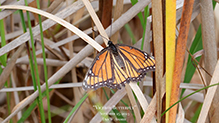 |
||||
Viceroy Butterfly... Seen it on a Prairie in Norman Co. Mn. July 24, 2022 ... I haven’t seen a whole lot of butterflies this season. Sightings are very sporadic and not abundant numbers by no means. There are plenty of prairie flowers blooming just not many butterflies. At least on the prairies I have been too recently. Maybe the drought and long heat wave last year and late Spring 2022 had something to do with it. |
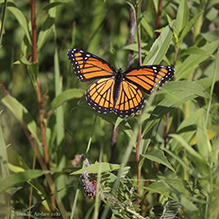 |
||||
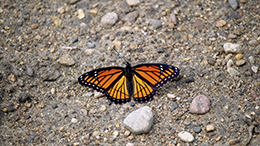 |
|||||
Tom Baker |
|||||
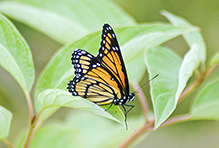 |
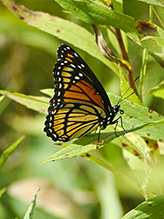 |
||||
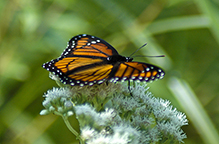 |
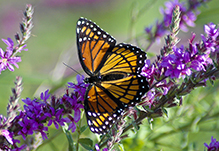 |
||||
MinnesotaSeasons.com Photos |
|||||
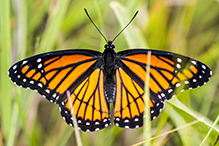 |
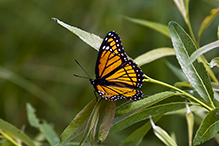 |
||||
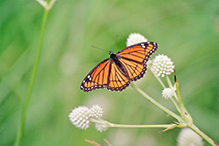 |
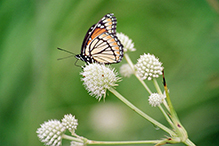 |
||||
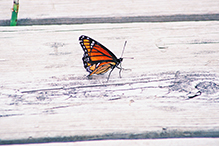 |
 |
||||


Visitor Videos |
|||
Share your video of this mammal. |
|||
| This button not working for you? Simply email us at info@MinnesotaSeasons.com. Attach a video, a YouTube link, or a cloud storage link. |
|||
Dan W. Andree |
|||
| "Monarch & Viceroy Butterflies" Filmed by Dan W Andree Published on Mar 23, 2016 |
|||
About
Short video shows some of the similarities as well as differences between Monarch and Viceroy butterflies. Filmed late in the summer of 2015 in Norman Co. Mn. |
|||
Other Videos |
|||
| Viceroy (Nymphalidae: Limenitis archippus) Carl Barrentine |
|||
About
Uploaded on Aug 19, 2009 Photographed at the Rydell NWR, Minnesota (18 August 2009). "The deeper our insight into the methods of nature...the more incredible the popular Christianity seems to me." --John Burroughs |
|||
| Viceroy Butterfly, "Butterflies-150" - September 14, 2013 Don Gagnon |
|||
About
Published on Sep 19, 2013 Viceroy (Limenitis archippus), Quansett Trail, Mass Audubon Allens Pond Wildlife Sanctuary, 1280 Horseneck Road, Westport, Massachusetts, Saturday morning, September 14, 2013, 10:59 AM / 11:03 AM - Canon PowerShot SX50 HS MVI_47471 / MVI_47492; 3:05 min. Music: "Butterflies-150" by Jonathan Priest (Soundtrack, 2:56) |
|||
| Viceroy (Nymphalidae: Limenitis archippus) Caterpillar Carl Barrentine |
|||
About
Uploaded on Jul 6, 2010 Photographed at the Turtle River State Park, North Dakota (06 July 2010). |
|||
| MVI_Viceroy.MOV jfrank12 |
|||
About
Uploaded on Sep 6, 2011 A Viceroy butterfly (Limenitis archippus) suns itself at Grand River Park in Ottawa County, Michigan. |
|||


Last Updated:
